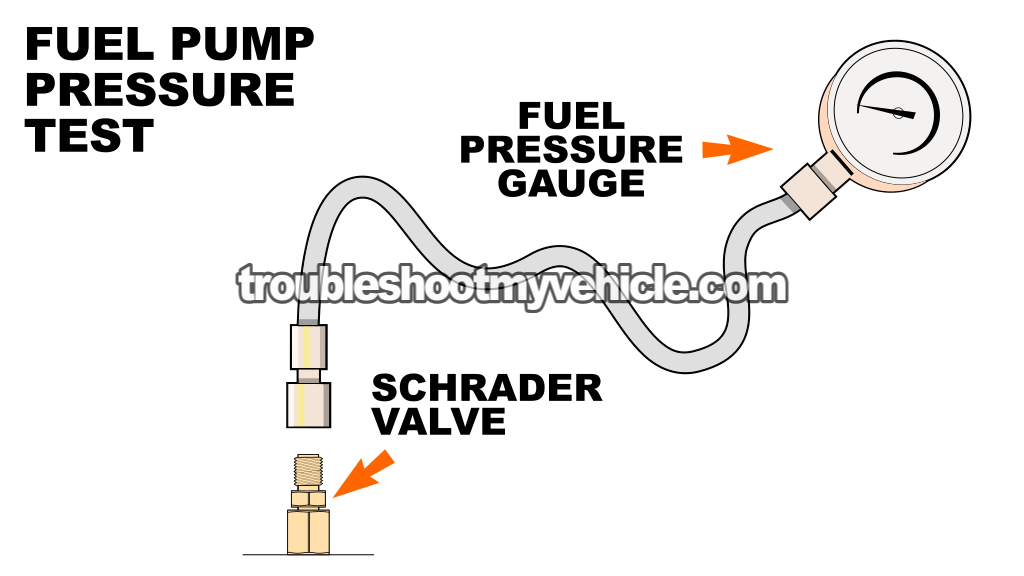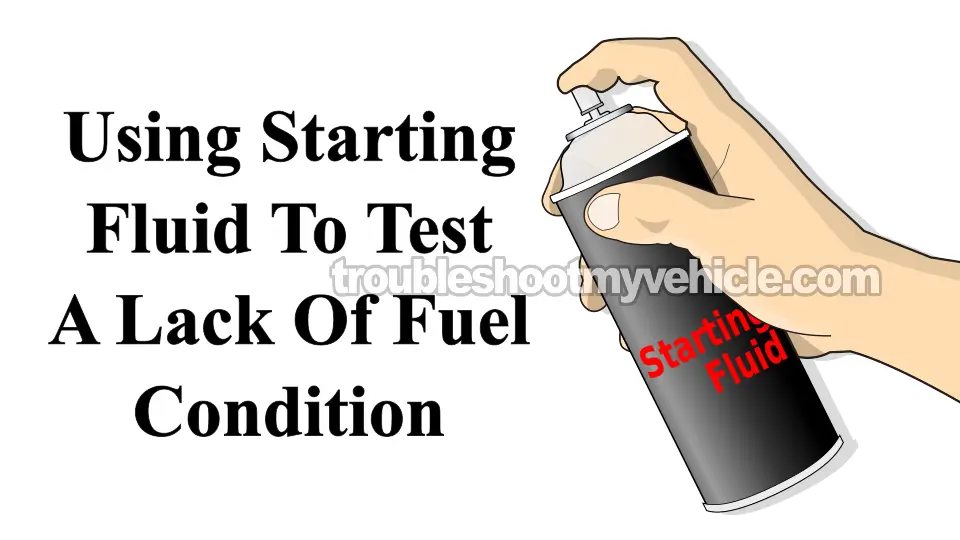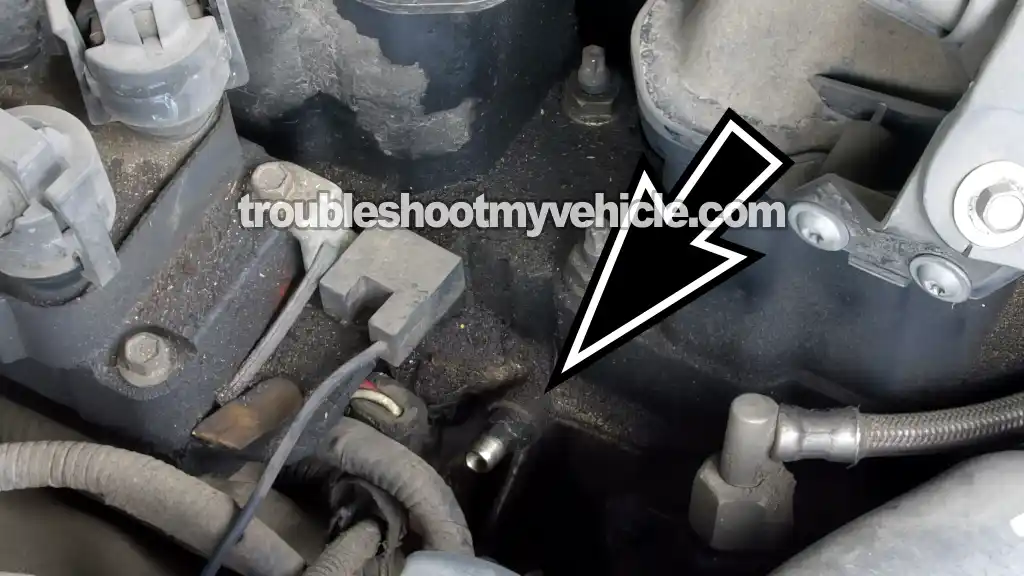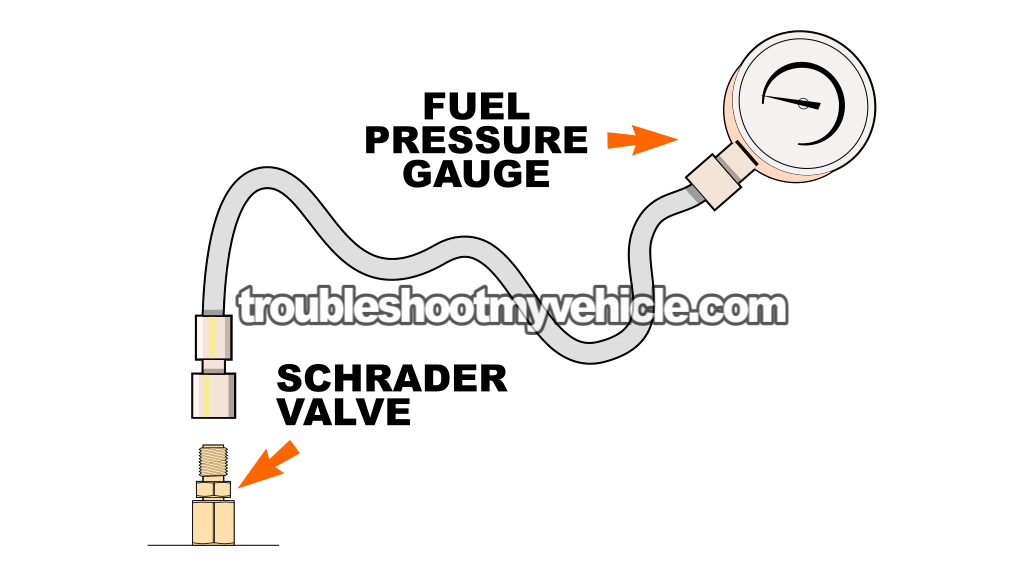
If the fuel pump fails, your Ford 4.0L V6 equipped SUV or mini-van is not gonna' start and run.
Thankfully, Ford has made it super easy to test the fuel pump on your 4.0L Ford Explorer (4.0L Mercury Mountaineer and 4.0L Ford Aerostar) and in this tutorial, I'll show you how to do it.
NOTE: You can find the 4.0L Ford Ranger (Mazda B4000) fuel pump test tutorial here:
- How To Test The Fuel Pump (1991-2011 Ford 4.0L Ranger And Mazda B4000) (at: easyautodiagnostics.com).
Contents of this tutorial:
IMPORTANT: Gasoline is extremely flammable! Take all necessary safety precautions, be alert, be careful. Starting fluid and gasoline can ignite very easily.
ES ![]() You can find this tutorial in Spanish here: Cómo Probar La Bomba De Combustible (Ford 4.0L) (at: autotecnico-online.com).
You can find this tutorial in Spanish here: Cómo Probar La Bomba De Combustible (Ford 4.0L) (at: autotecnico-online.com).
APPLIES TO: This tutorial applies to the following vehicles:
- 4.0L V6 Ford Aerostar: 1991, 1992, 1993, 1994, 1995, 1996, 1997.
- 4.0L V6 Ford Explorer: 1991, 1992, 1993, 1994, 1995, 1996, 1997, 1998, 1999, 2000.
- 4.0L V6 Mercury Mountaineer: 1997, 1998, 1999, 2000.
2001-2010 FUEL PUMP TESTS: The fuel pump test tutorial for the 2001-2010 4.0L V6 Explore and Mountaineer can be found here:
- How To Test The Fuel Pump (2001-2003 4.0L V6 Ford Explorer And Mercury Mountaineer).
- How To Test The Fuel Pump (2004-2010 4.0L V6 Ford Explorer And Mercury Mountaineer).
FUEL PUMP CIRCUIT WIRING DIAGRAMS:
- Fuel Pump Circuit Wiring Diagram (1993-1994 4.0L Ford Explorer).
- Fuel Pump Circuit Wiring Diagram (1995 4.0L Ford Explorer).
- Fuel Pump Circuit Wiring Diagram (1996 4.0L Ford Explorer).
- Fuel Pump Circuit Wiring Diagram (1997 4.0L Ford Explorer).
- Fuel Pump Circuit Wiring Diagram (1998-2001 4.0L Ford Explorer).
Symptoms Of A Bad Fuel Pump
When a fuel pump fails, it usually happens in one of two main ways:
- Engine Won't Start: The fuel pump just stops working altogether and the engine won't start because it's not getting any fuel.
- Engine Starts, But Runs Rough: In this type of failure, the fuel pump is on its way out, but it still manages to push enough fuel to get the engine started. However, it's not pumping enough fuel for the engine to run smoothly, especially when it's under load (like when you're driving).
Some common symptoms that the fuel pump might be failing or already has failed include:
- Engine Won't Start: You turn the key, but instead of starting, the engine just cranks and cranks without actually starting up.
- Stalling Right After Starting: Sometimes, the engine might start up OK, but then it putters out and stalls after just a few seconds.
- Stalling When You Hit the Gas: The engine manages to start, but the moment you stick the transmission in Drive and hit the gas pedal to accelerate, it stalls out on you.
- Lack Of Power When Driving: You notice that your vehicle just doesn't have the power it used to, especially when you're driving and need to speed up or climb a hill.
- Backfiring: If you hear loud popping sounds coming from under the hood when you're pressing on the gas pedal, that could be a sign of the fuel pump not delivering enough fuel to the engine.
- Check Engine Light On: If the check engine light is on your dashboard and you're getting trouble codes like P0171 or P0174, which are all about the air-fuel mixture being off, then your fuel pump could be part of the problem.
I want to point out before moving on the next heading, that other components (when they fail) can also cause similar problems/symptoms and mimic a failing fuel pump.
That's why it's essential to check the fuel pump's pressure output with a fuel pressure gauge before deciding to replace it.
Where To Buy A Fuel Pressure Gauge
Owning a fuel pressure gauge is one of those smart investments that pays for itself fast. Every modern vehicle uses an electric fuel pump to deliver high-pressure fuel to the injectors, and the most accurate way to diagnose pump performance is with a gauge.
Thankfully, on all the 1991-2003 Ford 4.0L V6 engines, there's a Schrader valve right on the fuel rail —which makes testing quick and easy.
Below are a few gauges I personally own or have used over the years. These brands have never let me down, and they come with the adapter you'll need to connect directly to your Explorer's fuel rail:
Disclosure: As an Amazon Associate, I earn from qualifying purchases. Buying through these links helps support this site at no extra cost to you. Thanks for your support —it really means a lot!
TEST 1: Fuel Pressure Test With Gauge
NOTE: If you're testing the 2001-2003 4.0L Explorer/Mountaineer, see this tutorial:
As mentioned at the beginning of this tutorial, testing the fuel pump with a fuel pressure gauge is very easy.
What makes it easy is that you'll find a Schrader valve on the fuel injector rail that you can connect a fuel pressure gauge to (see photo 1 of 2 above).
Using a fuel pressure gauge is one of the most accurate ways to ensure that enough fuel reaches the fuel injectors.
If you don't own one, you can run down to your local AutoZone or O'Reilly Auto Parts store and borrow one from them (for a small cash deposit, which you'll get back when you return the tool).
If you're interested in buying one, take a look at my recommendations here: Where To Buy A Fuel Pressure Gauge.
You can find the fuel pressure specifications here:
- Fuel Pressure Specifications (1991-1997 4.0L V6 Ford Aerostar).
- Fuel Pressure Specifications (1991-2010 4.0L V6 Ford Explorer, Mercury Mountaineer).
NOTE: If you haven't already checked the fuel pump inertia switch, do so before you start this test. For more info on the fuel pump inertia switch, take a look at this section: Checking The Fuel Pump Inertia Switch.
SCHRADER VALVE LOCATION: The Schrader valve, on the 4.0L Ford V6 engine is located on the injector fuel rail. To be a bit mores specific, it's on the passenger side of the engine between the ignition coil pack and the upper radiator hose. In photo 1 of 2 above, it's shown without its plastic cap.
OK, let's get started with this test:
- 1
Place a shop towel under the Schrader valve. The shop towel's job is to absorb any fuel that may leak when doing step 2.
- 2
Install the Ford Schrader valve adapter on the Schrader valve.
- 3
Connect the fuel pressure gauge to the Schrader valve adapter.
- 4
When ready, ask your helper to cycle the key ON and OFF but don't crank the engine while checking for fuel leaks.
If no fuel leaks, go to next step.
If fuel is leaking, resolve the leak before continuing to the next step. - 5
Have your helper to crank the engine while you observe the fuel pressure tester's gauge.
- 6
Your fuel pressure gauge will register one of the two following results:
1.) The fuel pressure gauge will register the indicated fuel pressure specification
2.) The fuel pressure gauge will NOT register the indicated fuel pressure specification.
OK, now that the testing part is done, let's take a look at what your results mean:
CASE 1: The fuel pressure gauge registered 0 PSI. This confirms that the cause of your engine's no-start problem is caused by a lack of fuel.
Now, I usually take two more precautions, before condemning the fuel pump as bad and this is to check:
- That the fuel pump inertia switch isn't activated and cutting power to the fuel pump. For more info on this take a look at the next section: Checking The Fuel Pump Inertia Switch.
- If the fuel pump inertia switch is OK, then I still make sure that the fuel pump is getting 12 Volts as the engine is cranking. This is just to make sure that the fuel pump relay and fuse are OK and doing their job. This guide will help you with this easy test:
To check that the fuel pump is getting power (after the inertia switch has been checked) you'll need to attach a multimeter in Volts DC mode to the wire that supplies this voltage to the fuel pump and while a helper cranks the engine, verify that the fuel pump is getting this power. If the 12 Volts are being supplied to the fuel pump, you have now 100% verified that the fuel pump is fried and needs to be replaced.
CASE 2: The fuel pressure gauge registered the correct fuel pressure specification. This fuel pressure gauge result lets you know that the fuel pump is working and delivering enough fuel to the fuel injectors.
The reason your 4.0L Ford vehicle is not starting is due to another reason. The fuel pump is OK. For more troubleshooting options, take a look at the following tutorial:
TEST 2: Using Starting Fluid

If you don't have a fuel pressure gauge handy, you can use starting fluid to see if the no-start condition of your 4.0L equipped Ford vehicle is due to a lack of fuel.
This method is not the most accurate way of testing the fuel pump, but it doesn't mean it's not effective.
The most important suggestion I can give you, before starting this test, is to make sure that all six cylinders are getting spark.
NOTE: If you haven't already checked the fuel pump inertia switch, do so before you start this test. For more info on the fuel pump inertia switch, take a look at this section: Checking The Fuel Pump Inertia Switch.
OK, to get this show on the road, this is what you'll need to do:
- 1
Remove the intake air duct from the throttle body. You don't have to completely remove it, since you'll have to reconnect it in one of the next steps.
- 2
Open the throttle, manually, and spray starting fluid down the bore.
- 3
When you have sprayed a good squirt of starting fluid, quickly reconnect the air duct to the throttle body (you don't have to tighten the hose clamp).
IMPORTANT: Reconnecting the intake air duct is a very important safety precaution in case you get a back-fire thru' the intake manifold. - 4
Have your assistant crank the engine once the intake air duct is back on the throttle body.
- 5
You'll get one of two results with this test:
1.) The engine will start momentarily and after a few seconds will die.
2.) The engine will only crank but not start at all.
OK, let's find out what your results mean:
CASE 1: The engine started and ran for a few seconds. This means that the root cause of your Ford vehicle's no-start is a lack of fuel.
Usually, this also means that the fuel pump is bad. But since we don't live in a perfect world, this could also mean a few other things like: the fuel pump fuse is blown, or the fuel pump relay is bad.
Your next step is buy or rent a fuel pressure gauge and actually check fuel pressure (your local auto parts store, like AutoZone or O'Reilly Auto Parts, will rent the fuel pressure gauge to you for free for a cash deposit which they'll return to you when you return the tool).
CASE 2: The engine did not start, not even momentarily. This usually means that a lack of fuel IS NOT the reason your car is not starting.
Now, remember what I said about this test not being very accurate? Well, I suggest you do one more test.
The next test is to actually verify the fuel pressure with a fuel pressure gauge. You can buy one or rent one (your local auto parts store, like AutoZone or O'Reilly Auto Parts will rent the fuel pressure gauge to you for free for a cash deposit which they'll return to you when you return the tool).
Checking The Fuel Pump Inertia Switch

Your 4.0L Ford Explorer (Aerostar, or Mercury Mountaineer) comes equipped with a fuel pump inertia switch, whose job is to cut power (or Ground) to the fuel pump in case of an impact.
When an impact causes the fuel pump inertial switch to activate, the engine will stall (if it was running) or crank but not start due to a lack of fuel.
Although it's designed to activate during a severe impact caused by an automobile accident, sometimes it gets activated by less than severe impacts (and this happens a lot).
You should always check and reset the inertia switch and try starting the engine before testing the fuel pump.
On the majority of the vehicles covered by this tutorial, the inertia switch is located below the right side of the instrument panel, behind the trim panel.
Resetting the fuel pump inertia switch simply involves pushing down on the button located on top of the inertia switch till it bottoms out. If the inertia switch has been jolted into shutting off the fuel pump, you'll feel a definite ‘click’ as you depress the button.
If you're needing to check the fuel pump inertia switch, to see if it's good or bad, this tut will show you how:
- Fuel Pump Inertia Switch Tests (1991-2010 4.0L V6 Ford Explorer, Aerostar, And Mercury Mountaineer).
Where To Buy The Fuel Pump And Save
The following links will help you comparison shop for the fuel pump:
Disclosure: As an Amazon Associate, I earn from qualifying purchases. If my tutorials help you, using these links is an easy way to support the site at no extra cost to you. Thank you!
Not sure if the above fuel pumps fit your particular 4.0L Ford? Don't worry, once you get to the web-site they'll make sure it fits (by asking you for the specifics of your vehicle). If it doesn't fit, they'll find you the right one.
More 4.0L V6 Explorer, Aerostar, And Mountaineer Tutorials
If you enjoyed and/or found this ‘How to’ article helpful, I have written several more 4.0L specific test articles. You can find here:
The following tutorials are a sample of the articles you'll find in the index:
- How To Test Engine Compression (1991-2010 4.0L V6 Ford Explorer, Aerostar, And Mercury Mountaineer).
- How To Test The Fuel Injectors (1991-1996 4.0L Ford Explorer And Aerostar).
- How To Test The Coil Pack (Ford 3.0L, 3.8L, 4.0L, 4.2L) (at: easyautodiagnostics.com).
- How To Test The Ford Mass Air Flow (MAF) Sensor (at: easyautodiagnostics.com).
- How To Troubleshoot A No-Start Problem (1991-2010 4.0L V6 Ford Explorer, Aerostar, And Mercury Mountaineer).

If this info saved the day, buy me a beer!








